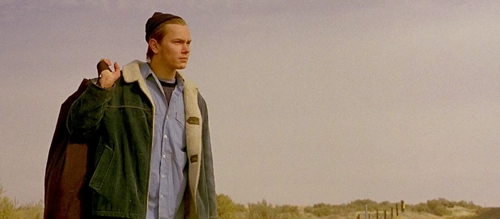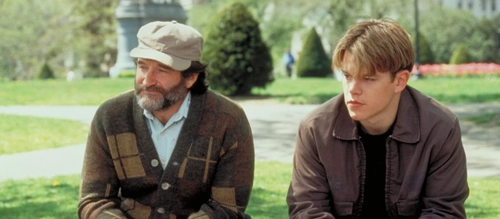Where to Start with Gus Van Sant
Labelled as one of the most influential creators from the New Queer media movement, Gus Van Sant is a filmmaker who continuously captures the fragility and beauty of human existence in his films.
Van Sant worked his way up the ranks of filmmaking by acting as a production assistant to producer Ken Shapiro before creating his first film Alice in Hollywood, a feature that was never released. In these early days, he began to observe the cultures around him, with one of his favourite people-watching posts being downtown Hollywood where the surroundings differed far from the neighbouring Beverly Hills. Inspired by the marginalised communities that populated the area, Van Sant once again returned to the director’s chair, making Mala Noche (1986), a love story entwined with themes of immigration and urban poverty. While the film remains primarily unrecognised against Van Sant’s mighty filmography, Mala Noche is where Van Sant’s distinct style began.
Following Van Sant’s introduction to film festivals and premieres, big-name studios such as Universal Pictures began to take note of the upcoming creator. The kinship eventually sizzled out after Van Sant pitched a handful of unsuccessful ideas, yet ironically the rejected pitches would become cinematic staples, including Drugstore Cowboy (1989) and My Own Private Idaho (1991). Fast forward to the immensely successful release of both of these films, Van Sant began to rub shoulders with the mainstream market, making beloved films such as Good Will Hunting (1997), Elephant (2003), Milk (2008), and Don’t Worry, He Won’t Get Far on Foot (2018).
Despite his career flourishing and his work expanding to the masses, not once has his quintessential methodology changed; every single one of his films is confrontational, exploring drug use, mental illness, gun violence, hate crime and suicide with a relentlessly heavy hand. To help navigate his dense filmography is The Film Magazine’s official guide on Where to Start with Gus Van Sant.
1. My Own Private Idaho (1991)

The early days of Gus Van Sant’s career saw him create a film steeped in allegories concerning the everlasting polarisation of society. It is about the outsider looking in, the inherent conflicts that consistently arise concerning class and queer love.
My Own Private Idaho follows best friends Mike (River Phoenix) and Scott (Keanu Reeves) as they venture to find Mike’s distant mother. Van Sant ingrains the aesthetics with a level of intimacy that contrasts and compliments the vast landscapes that the film traverses, with the centrality always adhering to the bond between Mike and Scott no matter the boundless road movie scenery. They never become swallowed by the detailed landscapes they travel across; instead, Van Sant locates focus on the incredibly emotional voyage that the two young men go on.
Van Sant consistently infuses elements of individuality into his work, with My Own Private Idaho being no exception. The film is loosely based on the Shakespearean tales “Henry IV, Part I” and “Henry IV, Part II”, whose origins circulated in the late 1500s. These tragedies explored familial expectations and battles between freedom and self-expression, as seen in My Own Private Idaho; however, Van Sant’s gust of modernity coupled with the film’s dream-like quality amplifies the harsh truths that come with brooding introspection unlike ever before.
2. Good Will Hunting (1997)

5 Moments in Good Will Hunting That Will Give You Chills
Good Will Hunting has a place on nearly every list defining cinematic classics, and rightfully so.
Gus Van Sant takes us on a journey of self-discovery, as we see Will Hunting (Matt Damon), a janitor at MIT, form an unlikely but life-affirming friendship with psychology professor Sean Maguire (Robin Williams).
The film is brimming with some of the most moving scenes in film history, whether that be lectures from Maguire or moments of heartfelt anger outbursts from Will as he struggles with his own fears of progression. Whilst Van Sant’s fantastic directing beautifully captures the sincerity of the narrative, the most impressive factor is how the director allows the film to speak for itself.
There is a purposeful lack of whimsy within the camera work, forgoing eccentricity in favour of letting the earnest dialogue take over, encouraging us to sit and become utterly engrossed in the profound venture that the characters go on.
3. Elephant (2003)

Gus Van Sant has never one to shy away from the brutal truths of reality, Elephant being the filmmaker’s telling of a topic that has never seemed more relevant: a mass shooting.
Elephant follows a group of students, unaware that a mass shooting will soon occur. The film is partially based on the Columbine High School Massacre of 1999, taking heed of the tragedy and forming a film that does not sensationalise or create a spectacle but instead uses bleak monotony to root the narrative as a realist piece. The film acts as a challenge, not one that dares us to carry on watching as a play of twisted entertainment, but in the way that Van Sant portrays the acts of violence as authentic.
Rather than conjure a script with adolescent dialogue written by middle-aged writers, Van Sant created an ongoing script that formed concurrently to the filmmaking, where improvisation was encouraged. The result is a film that plays out with an uncomfortable level of validity.
Elephant’s execution was warmly received by critics and moviegoers alike, with much of the critical reception favouring the unforgiving way the narrative unfolded. Van Sant’s cold take on a matter so close to the hearts of many eventually won him the Palme d’Or at the 2003 Cannes Film Festival, outperforming the likes of Dogville, Swimming Pool and Mystic River.
Recommended for you: Where to Start with Jonathan Demme
Gus Van Sant yields a specific power with the camera, with every one of his films encroaching upon the real and infecting the screen with a potent ferocity that fails to quit. From sweeping melodramas to gut-wrenchingly confrontational slices of life, Gus Van Sant’s filmography is both rare and more than worthwhile to explore.

